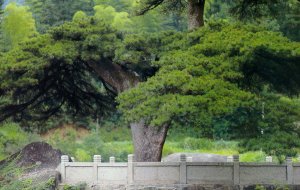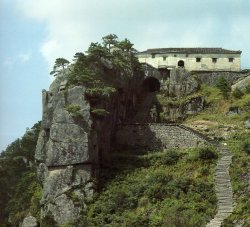|
Mount Jiuhua was originally known as Jiuzi (Nine-Peak) Mountain. But ever since Li Bai, the celebrated poet in the Tang Dynasty wrote of the mountain: "Sailing down the Jiujiang River the other day, I saw the Jiuhua Peaks in the distance. Looking like a heavenly river hanging in heaven, Its green water embroidering cottonrose hibiscuses.", the mountain was renamed as Mount Jiuhua. Mount Jiuhua is located in the Qingyang County of the Anhui Province and covers more than 100 square kilometres in area. The Shiwang Mountain, the main peak, is 1342 meters above sea level. Mount Jiuhua is full of waterfalls, streams, exotic-looking boulders, ancient caves, old pines and exuberant bamboo. With the richly variegated landscape, the ancient temples are tucked away amid the dense woods, and the air reverberates with the tolling of the bells at dawn and dusk. Mount Jiuhua is usually known as the Number One Mountain of the Southeast. The 10 major sights of Jiuhua are as follows: 1. The mountain scenery by the Five Streams 2. The waterfall at Taoyan 3. The moon mirrored in the Shutan Pool 4. The serene form of the East Cliff 5. The snow mantle over the Flat Terrace 6. Evening Bell Tolls at Huacheng 7. The Sea of Clouds around the Lotus Peak 8.The Singing Stream at Jiuzi 9. Cellestial Presence at the Heavenly Pillar 10. Sunrise at the Heavenly Terrace 
The great variety of the beauty of Mount Jiuhua ranges from the hair-raising to the gracefully tranquil. And the scenery keeps varying with the seasonal changes. For instance, the Sea of Bamboo at Minyuan covers 1000 acres (mu), and when the wind blows, the bamboo leaves sibilate with an ear-pleasing cadence while the streams are gurgling and the springs gushing in the background. Standing by a mountain path that threads its way through the Sea of Bamboo is the renowned Phoenix Pine, the so-called "Number One Pine in the Land Under Heaven", which was planted during the Northern and Southern Dynasties, around 1,400 years ago. The tree's verdant foliage, together with its flat, scaly twin trunks form what looks like a green phoenix craning it's neck and flying towards the Heavenly Terrace.

The Huacheng Temple is the oldest of all the temples of Mount Jiuhua. It is located at the hub of the entire mountain and surrounded by the Baiyun Mountain to the north, the Furong Ridge to the south, the East Cliff to the east and the Shenguang Ridge to the west. It was said that this temple was first built as the residence for Kim Gio Gak.. Later the temple was inaugurated as the bodhimandala of the Ksitigarbha Buddhisattva in 781, the second year of the Jianzhong reign of the Tang Dynasty. The entire temple, looking venerated in a solemn design, rises layer upon layer according to the contour of the mountain slope. The front door of the temple opens on a stream, the farmland and a street, and the centre of the square is a crescent moon-shaped pool in which the captive fish are set free. The Tripitaka pavilion in the rear has been converted into an exhibition of more than 1,300 Buddhist cultural artefacts, which include 6,777 volumes of Buddhist scriptures given to the temple by the Emperor Wanli of the Ming Dynasty, with the scriptures inscribed on pattra leaves, and a nine-dragon square seal of Kim. As a Buddhist sanctuary and a national scenic resort, Mount Jiuhua is a Mecca for both tourists and pilgrims from around the world. This is particularly so on the birthday of Ksitigarbha Boddhisattva, July 13th of the Chinese Lunar Calendar. Around that day every year, the mountain is the site of a temple fair. Monks and pilgrims congregate at the Pagoda of the Holy Body to stand vigil for the Ksitigarbha Bodhisattva, and Mount Jiuhua is enshrouded in the smoke of burning incense, the air is resounded with the chanting of incantations and the beating of drums, gongs and the tolling of bells. |